Solid Ways to Improve Dwell Time in Your Website
Dwell time refers to the average time visitors spend on your page.
High dwell time indicates a lot of good things. For one, it means your visitors like your content.
It may also mean that your website is well-optimized and structured well from a UX design perspective. More importantly, it’s an SEO factor that could rocket you to the top of search engine results.
So, wouldn’t you agree that dwell time is one of the top UX metrics?
With all that being said, low dwell time is definitely not something you can simply brush off.
Let me walk you through the steps that will improve dwell time on your site.
1. Using visual content wisely
A surefire way to make people stick around is to give them something to view.
Statistics show that the effective use of visual content results in around 94% more views.
There are a lot of ways to obtain presentable visuals without hiring a professional graphic designer.
For stock images, you can refer to sites like Pixabay where you can download them for free. You can also use a cloud-based tool like Piktochart to whip yourself up some custom images in minutes.
Not convinced that you should use visual content?
Here’s one more fact — about 90% of all the information sent to your brain is visual. And compared to text, images are processed faster — 600,000 times faster, to be exact!
That makes it easier for your readers to digest your content, trust your brand, and be ready to convert into subscribers or paying customers.
Here are the types of visual content that you should look into:
- Infographics. They can cover heavy, data-driven topics in a more presentable and visually-appealing way.
- Presentations. Like infographics, they’re rich with information. And because they can contain loads of information, they can help you discuss a subject better — especially when shared through a platform like SlideShare!
- Images. Facebook posts and tweets get higher traffic when they are accompanied by images. They can maximize engagement in the form of comments, likes, and shares.
- Videos. Lastly, videos build trust, can engage even the laziest people, and boost conversions. More leads are generated for those who turn to video content marketing!
2. Make a good internal linking structure
Apart from improving dwell time on your website, having a solid internal linking structure is great for SEO.
69% of visitors turn to internal recommendations to get inspiration on where to go next.
All you have to do is swoop in and grab the opportunity!
Remember, dwell time is calculated as the time between your visitors are on your site and them returning to a search engine. So, trying to encourage them to check out more content from your site is more than practical.
And let’s say that, yes, your page is exceptionally useful. You may even get tons of praise for it.
Unfortunately, not all of your visitors think alike. While some of them like your content, the rest don’t. This second group would rather view the other sections of your site in favor of the original one they accessed.
The good news? Internal links can get them to where they want to go — just slide them into your content or perhaps as sidebar navigation links.
This also has a positive impact on your site’s bounce rate.
All of these are good things. After all, if you have a high bounce rate for your page, it means your visitors find a particular page off-putting. But since they can easily view other pages through internal links, they may decide not to leave your site right then and there.
For a refresher, bounce rate refers to the percentage of your visitors that navigate away from your site after visiting just one page.
You do, however, have to be mindful of the content pieces you connect with internal links.
Unless you’re using a sidebar navigation widget or menu, linked posts must be related to the original post to avoid disrupting the user experience.
If WordPress powers your site, some examples are YARPP (Yet Another Related Post Plugin) and Related Post. These work by finding and suggesting related content that you can internally link to.
If you’re struggling to find ways to use internal links, sometimes it’s best to just be upfront.
What a lot of websites do is create a “related content” list on their posts.
Here’s an example of a section on a page with more resources (a list of related posts) that you can check out.
3. Make your content more readable
You already know that an effective content strategy can do wonders on any site.
It can uplift your conversion rate, generate engagement, and maximize site dwell time.
After all, quality content is what your visitors want. And quality content is what you should give them.
A lot of site owners know this already. But what they don’t know is this: great content can’t exist without readability.
Some of them only create content for the sake of having content on their website.
They think as long as it can be published on their site, it’s already good stuff. Unfortunately, it’s the wrong approach!
Readability is all about making your content more digestible and less stressful to users. The thing is, this isn’t something that can be accomplished with brilliant writing alone.
Without further ado, here are the ways on how to make your content more readable:
- Use strong subheadings. Not all of your visitors will read your content all the way through — some of them would rather skim through the whole thing with the help of subheadings.
- Avoid thick walls of text. Stacking up text blocks one after the other makes your content difficult to read and boring. In addition to subheadings, you can give readers a break from text with custom visuals like infographics, animations, or even memes.
- Understand the intent behind keywords. An effective long-tail keyword strategy not only focuses on keywords that pull in traffic. It also factors in user intent to avoid any mismatches between your content and the information readers expect.
- Observe proper grammar. Nothing causes readers to leave faster than unprofessional content loaded with grammatical and spelling mistakes. Here’s another hot tip: read your content aloud to make sure it sounds natural to native English speakers.
Last but not least, it’s key to produce content loaded with updated, valuable information. Because you want your readers to find your page useful, the only solution is to create something absolutely stellar.
Take the time to review what you write — don’t embarrass yourself by publishing false or outdated information.
If you don’t, then don’t be surprised to find your dwell time shrinking and bounce rate climbing.
4. Improve page loading speed
100 milliseconds’ worth of delay is all it takes for conversion rates to go down by 7%.
Scary, right?
We’re talking about just milliseconds here.
Nobody likes to be kept waiting. Not even you!
To make sure your website’s speed is acceptable, start by going to PageSpeed Insights. From there, enter your website’s URL on the search bar and hit ANALYZE.
This will diagnose that page’s speed and give you a pagespeed score from 0 to 100:
- Slow = 0-49. Your page takes too long to load. Even if it can be useful, your visitors are highly likely going to abandon it.
- Average = 50-89. Your page’s speed is okay. If your content is useful, your visitors might wait for it to load.
- Fast = 90-100. Your page loads quickly! It’s easy to attract visitors – and get them to stay. You just have to keep it up.
Here’s an example. I entered the URL of vertigohomeremedies.com’s landing page and it received 100. This means that its current speed is fast!
Based on the findings, PageSpeed Insights will provide you with a list of actionable recommendations.
Here are some of the typical fixes you could do:
- Use caching plugins. Caching allows web browsers to download an offline version of your site so it won’t have to load from scratch next time. WP Rocket and W3 Total Cache automatically enable this on WordPress websites — there should be similar apps for other website platforms.
- Compress media files. ShortPixel offers lossy and lossless compression. Lossless compression reduces file size without any noticeable differences in quality.
- Rely on a better web host. This should be rather self-explanatory. Hosting quality and site performance go hand in hand — don’t get stuck with a bad hosting service provider!
- Use a Content Delivery Network. A CDN speeds up website file transfers by utilizing a network of geographically-distributed proxy servers. It is, however, only beneficial for sites that already generate thousands of traffic from across the globe.
5. Be mobile-friendly
Did you know that 70% of internet traffic comes from a smartphone, tablet, or any other mobile device?
If your site is mobile-friendly, you just won over lots of people.
Otherwise, they’ll scoot. If you put yourself in their shoes, you’ll do, too.
It’s a huge inconvenience to navigate a site that doesn’t display properly on mobile devices.
No clue if your site is optimized for mobile?
Worry not. All you have to do is run a test to see how easily mobile users can use your site.
For example, I checked Search Engine Journal’s homepage on the Google Mobile-Friendly Test.
Now, it’s your turn.
Just like PageSpeed Insights, there should be some actionable suggestions you can start with.
Below are some examples:
- Use responsive design. Choose a template that will make your content always accessible regardless of the user’s device. Most website platforms like Wix, WordPress, or Duda already have loads of ready-to-use, responsive themes — use them.
- Say NO to Flash. Put simply, not all mobile devices support it. Not to mention that it’s terrible for SEO.
- Use large font sizes. Otherwise, reading your content on a small screen can be a chore.
- Use large button sizes. Finally, your website buttons should be large enough so users can comfortably tap on them using their phones. Imagine how frustrating it is to tap on the wrong things due to poor design!
Wrapping it up
Remember, there isn’t a single magic fix that can instantly improve dwell time. You can’t even expect matters to go well after applying any of the techniques mentioned above.
If I were you, I’d start from top to bottom and constantly monitor my site’s performance. This should help me identify what works and what doesn’t.
Good luck!























